New research has brought an original unifying explanation for the physiological, behavioural and cultural evolution of the human species, from its first appearance about two million years ago, to the agricultural revolution (around 10,000 BCE).
The paper written by Dr Miki Ben-Dor and Prof. Ran Barkai from the Jacob M. Alkow Department of Archaeology at Tel Aviv University said that human development as hunters of large animals caused their ultimate extinction.
The recent years have seen more evidence and information telling us that humans were a major factor in the extinction of large animals and consequently had to adapt to hunting small game, first in Africa and later in all other parts of the world.
Around 2.6 million years ago, the average size of land mammals was about 500kg. This was the time when humans first emerged. This number has fallen over 90% just before agriculture.
The team added that the decrease in size and need for hunting small, swift animals forced humans to display cunning and boldness.
This led to increased brain volume and also led to the development of language, enabling the exchange of information about where the prey could be found. The theory claims that all means served one end: body energy conservation.
The brain volume grew from 650cc to about 1500cc because of their adaptation to hunting small and swift prey animals. This developed higher cognitive abilities, thus growing their brain volume.
The theory says that early humans were top predators, specializing in hunting large game. These large animals provide humans with high-fat levels, an essential source of energy, and enable a higher energy return than a small game.
Previous studies show that more than half of the biomass of all herbivores hunted by humans was there in about six different species of elephants that lived in Africa. There is evidence showing that homo sapiens only emerged in East Africa after a significant decline in the number of elephant species in certain regions. Study over many regions showed that there was a significant decline in the prevalence of animals weighing over 200kg, coupled with an increase in the volume of the human brain.
Hunting small animals generated prolonged evolutionary pressure on the brain functions of humans, who were now using up much more energy in both movement and thought processes.
The cognitive activity also rised as fast-tracking requires fast decision-making, based on phenomenal acquaintance with the animals’ behaviour—information that needs to be stored in a larger memory.
Decrease in size of animals and increase in technology made it more efficient hunting of medium-sized and small animals toward the end of the Stone Age, as animals became even smaller, humans had to put more energy into hunting than they could get back. After the Agricultural Revolution occurred, involving the domestication of both animals and plants, brain size decreased to its current volume of 1300-1400cc.
Prof. Barkai notes, “While the chimpanzee’s brain, for example, has remained stable for 7 million years, the human brain grew threefold, reaching its greatest size about 300,000 years ago. Barkai added that evolutionary pressure caused humans to use language, fire and sophisticated tools such as bow and arrow, adapt their arms and shoulders to the tasks of throwing and hurling and their bodies to the prolonged chase, improve their stone tools, domesticate dogs and ultimately also domesticate the game itself and turn to agriculture”.
Wherever humans appeared—whether homo erectus or homo sapiens, we see, eventually, mass extinction of large animals.
Journal Reference:
Miki Ben-Dor et al, Prey Size Decline as a Unifying Ecological Selecting Agent in Pleistocene Human Evolution, Quaternary (2021). DOI: 10.3390/quat4010007

